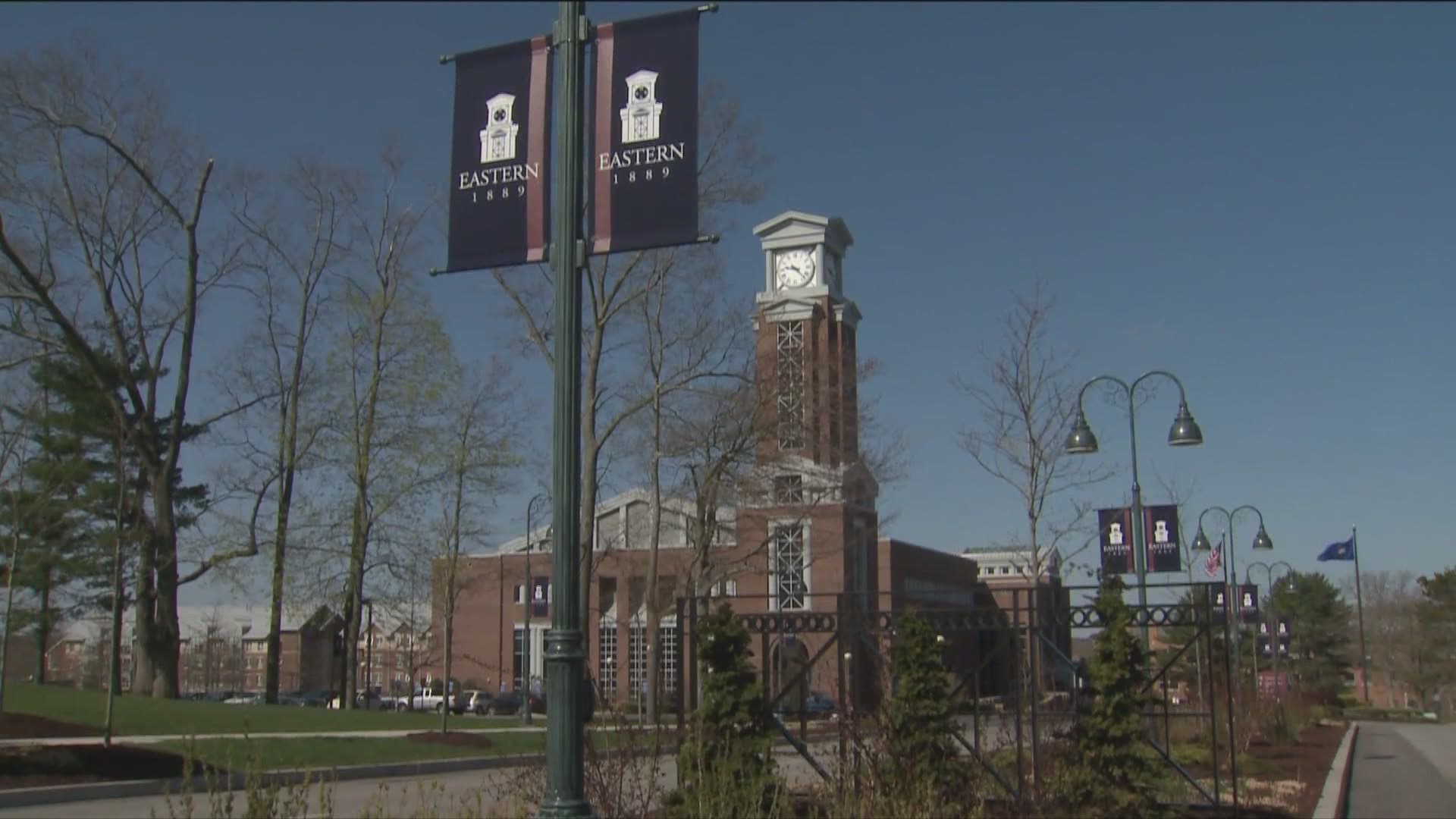HAMDEN, Conn. — As Universities and Colleges prepare for the upcoming fall semester, Quinnipiac University announced the school is facing a $55 million budget shortfall due to the COVID-19 pandemic. QU released a letter explaining it will be taking eight actions to lessen the budget pressures.
The school will be placing 130 employees on temporary furlough and will lay off 38 employees. The cuts will be made to both the staff and faculty. The school said the average furlough will be six weeks and range between two weeks and six months. Those who are furloughed can also apply for unemployment benefits. The layoffs will go into effect on July 1.
Management Committee and Leadership Council members have made voluntary decisions to take 5% and 10% cuts in their full-year salaries. President Judy Olian will continue to take a 20% salary cut.
“Approximately $10 million in new expenses related to COVID-19 and a slightly lower enrollment require us to address a budget shortfall for the 2020-21 academic year," said Daryl Richard, vice president for marketing and communications. "Our goal is to minimize the impact on our faculty and staff to the greatest extent possible and to create a healthy learning environment for our entire community as we make these difficult decisions with care and compassion. The actions we take now will position the university to navigate the next year successfully and to thrive and grow in the years ahead.”
Quinnipiac will also be pausing its study abroad program, Type 1 and Type II sabbaticals, and university travel. A hiring freeze announced on May 28, will continue.
For the latest Quinnipiac COVID-19 information, click here.
Read the full letter below:
Dear colleagues,
I want to thank you, once again, for the collective resolve and commitment to our educational purpose that you have demonstrated, time and time again, over the last few months as we respond to the COVID-19 pandemic, and join in meaningful reckoning with historical racial injustice. At a time such as this, I am grateful to be a part of such a principled and caring community.
Turning to the effects of the pandemic, we expect repercussions for some time as we are a community of 12,000 students, faculty and staff that comes together in classrooms, residence halls, libraries, laboratories, offices, athletic arenas, and more. The financial pressures created by the pandemic are compounded by the slightly lower enrollment for a second year in a row, and by the necessary costs to protect our collective health and safety against the ongoing risks of COVID-19.
Today I am writing to share with you an update on Quinnipiac’s planned actions in the coming year to alleviate budget pressures, and to position our university to thrive long-term as we continue to advance our strategic objectives.
The budget pressures we are addressing
The 2020-21 budget requires us to address an approximately $55 million shortfall. This is largely driven by two factors: enrollment declines in both the 2019-20 and 2020-21 academic years (though new enrollments this year are stronger than last year); and approximately $10 million in new expenses related to COVID.
As a result, we have had to make extremely tough decisions. I speak for the entire leadership team when I say that this moment weighs very heavily on our minds and in our hearts, and we know that it has led to significant anxiety and concerns throughout our community. To alleviate uncertainty, I am laying out, as transparently as possible, what we now know. Our decisions are guided by the imperative to address the financial demands of our current situation, while continuing to deliver outstanding educational excellence for which Quinnipiac is known.
1. Furloughs and layoffs
The employees of Quinnipiac are the reason for our university’s distinctiveness as a place to learn and work. As approximately 60% of our overall expenses are committed to employee compensation and benefits, as we address our financial situation we cannot avoid examining personnel costs alongside other expenses.
We have come to the very difficult decision to temporarily furlough approximately 130 employees and to layoff approximately 38 employees. These actions impact both staff and faculty positions and decisions were made by the academic and administrative units as part of the measures taken to meet their budget targets. A few important notes about these actions:
- Furlough decisions and timing are based on business operations and the nature of the employee’s job; the average furlough will be six weeks, ranging two weeks to six months.
- All employees on furlough will retain their benefits coverage, and QU will increase to 100% its coverage of the employee’s share of health insurance premiums so employees on furlough do not incur any out-of-pocket expenses for health insurance.
- Employees on furlough will also be eligible to apply for state unemployment benefits, which, when supplemented by the federal stimulus package, can in some cases replace most or all of any lost wages.
- Layoffs will be effective July 1, 2020 and managers will complete their conversations with individuals whose role was affected by the end of tomorrow. Some transition benefits will be provided to laid off employees.
As much as possible, we tried to minimize the impact on our faculty and staff. These staffing decisions address approximately 12% of our overall budget shortfall, and we turned to other actions outlined below to address the vast majority of our 2020-21 budget cuts.
2. Restoring salaries to their previous levels
We recognize that many employees are working harder than ever as we adapt to new models of delivery and operations in a world with COVID-19. We will be restoring all employees’ base salaries to levels effective before the April 1 cut. As an aside, even if we had continued the salary reductions beyond July 1, we still would have had to make the tough decisions outlined above due to the enormity of the COVID-19 and enrollment impacts.
3. Voluntary cuts in leadership salaries
Members of the Management Committee and Leadership Council have made voluntary decisions to take cuts of 5% to 10% in their full-year salaries to contribute to university budget savings. As president, I am continuing for the upcoming academic year the 20% salary reduction I had taken earlier.
4. Continuing our hiring freeze
As announced on May 28, the university-wide hiring freeze will continue in 2020-21 for all faculty and staff positions, including temporary hires. As each school and unit built their 2020-21 budget, staffing levels were assessed against the current academic and operational needs of a smaller student body, while keeping an eye on future strategic priorities. While there will be very few exceptions to the hiring freeze, there is an exception request process in place.
5. Voluntary Separation Program
Academic units were provided the opportunity to offer a Voluntary Separation Program for tenured faculty. The College of Arts and Sciences and the Schools of Business, Communications and Nursing elected to participate. This early retirement program is based on the completed number of years of service as of June 30, 2020 and eligible faculty have until June 30, 2020 to make their decision.
6. Study abroad, sabbaticals and travel
We are pausing the 2020-21 academic year study abroad program, Type I and Type II sabbaticals, and all university-sponsored travel. Aside from the reality of travel restrictions persisting throughout the year and the financial savings this will produce, it is also a prudent step as we continue to observe appropriate health protocols to limit possible contagion of COVID-19 in the university community.
7. Reducing our operating expenses
All deans and administrative unit heads determined how to make necessary adjustments to their budgets for the 2020-21 fiscal year based on enrollments for their respective school, unit operating priorities, and targeted restructuring based on their long-term vision. In addition to deciding on the previously mentioned staffing adjustments, some deans have also increased revenue through new programs. Reductions in operating expenses amounted to approximately 53% of the overall budget measures.
8. Slowing our capital programs
We will slow our capital programs and reduce our originally planned capital spend for 2020-21 by nearly $10 million.
Moving forward
Regardless of the concerted attempts to minimize the impact of these reductions on our faculty and staff, these decisions are among the hardest we’ve ever confronted at Quinnipiac, and no doubt they will cause sadness and hardship. I can say that each decision was labored over, considered from every perspective, and ultimately made to protect the university’s future and fulfil our academic mission.
We are experiencing challenging times, yet these difficult decisions are essential to position us to navigate the next year successfully, and to thrive and grow in the years ahead. The Reimagining Committee did exactly that in the report it just delivered—it reimagined the University of The Future post-COVID-19 with breakthrough ideas that will distinguish us in principles, people and programs.
Please know how deeply I appreciate the dedication you have for Quinnipiac and for our students as we advance, with courage and resolve, through this difficult phase into the next bright chapter of QU’s history.
Be well,

Judy Olian, President
Quinnipiac University


